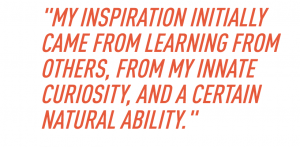Written by William Ryder
Packaged by Maeve Allen
Students in Professor Lindsay Lennon’s Feature Writing class were assigned to interview SUNY New Paltz alumni who were featured in Wired Gallery’s “Golden Age of New Paltz” exhibition. Here’s what they found:
Jerry Vis is an architectural designer who, at 79 years old, still remains creatively curious when it comes to making art.
Architectural designer Jerry Vis from New Jersey is a prominent figure in “The Golden Age of New Paltz.” He spends half the year in the Hudson Valley and half the year in Monhegan Island, Maine. Vis graduated from New Paltz with a bachelor’s degree in education, then Rutgers University with a Master of Fine Arts. He had a very successful career in the New York City art scene upon receiving his master’s degree. Vis owns a house in Rosendale that was featured in Chronogram magazine for the elegance he and his family put into the home. Vis resides with his wife, Betty Lou, and their three children. He also owns a small family business called Cottage Industries, located in Ulster County, which consists of “construction and design consultation, architectural planning/designs, ground-up constructions with a keen attention to finish detailing, and green building techniques.”
What do you love about art?
My relationship with art is not a love affair. It is more like a continuation of the kind of curiosity a toddler has about the world around them. That curiosity is not about love but understanding the larger world beyond the confines of my body and mind.
What inspired your work?
My inspiration initially came from learning from others, from my innate curiosity, and a certain natural ability. As I’ve grown older and discovered what my questions about life are, [inspiration] has become the actual process—the creative process itself that motivates me. The art objects created are more like footnotes to the search, not the end goal.

Why architecture and sculpture?
Simply because I had a natural ability to visualize three-dimensional forms. The architecture, because it gave me an enjoyable way to make a living. Sculpture, because it is an end in itself—it is its own reason for existence.
How do you start a project?
One of the most difficult problems when you are young is finding the motivation for starting whatever. I, too, had that problem. But the lure of the unknown and the reward, at first very small, of mastering something overtakes you. You just need to keep at it. I had to learn to give up short-term diversions for long-term meaning. Now, I no longer have a problem with motivation. Even if I wake up feeling indifferent to the day I know that, even on the worst days, the act of creating will take me over and before I know it, I’m on my way to a much better day.
Do you currently take art classes?
I no longer take art classes. I have, off and on, taught them. I went to Parson’s School of Design in the early ’60s, then New Paltz to get a degree for teaching. Then I went to Rutgers University in the early ’70s for a Master’s degree.
Do you have any other interests?
Yes. Fiction and non-fiction writing. At this point I would say that half of my creative effort and time is spent writing. I like to cook, hike in the woods, and read and/or watch British mysteries on TV.
What do you do currently?
I will be 80 years old next February. And I am fortunate that I can still do everything I have ever done in life, just a little bit slower. The fringe benefit of aging in this culture is you become invisible, which in my case allows me the ability to observe the ludicrous and meaningful behavior of people for my writing.
What does art mean to you?
Art, the creative process, has been and still is, everything. It has not brought me fame. It has not brought me wealth. It has brought me the best reason to live. It has brought me meaning for living. I believe it doesn’t matter what you do in life, just do it well, do it honestly and never selfishly.
Read about other #GoldenAge artists here:
Jack Murphy offers a snapshot of what it was like to be an artist in New Paltz during the “Golden Age,” and his inspiration behind curating the exhibition.
Jo-Ellen Trilling is an artist from the era of protest art in 1968 to 1971 who intertwines magical realism with art to reflect life within the political climate at the time.
Ed Samuels began drawing early in his childhood after being influenced by his family of artists. He found his niche during the ‘60s and ‘70s after seeing the beauty in all environments, from New York City streets to Sante Fe’s cliffs and beaches.
Jon Ellis Stevens is an award-winning photographer and New Paltz alumnus. He discusses his desire to show that photography is more than capturing still images and how the radical times of the ‘60s inspires his artwork.
Sevan Melikyan is a native from Turkey who journeyed with the dream of becoming an artist to America, where he became enthralled with the rich artistic history of New Paltz.
Eileen Cowin is a multi-medium artist from New York who creates politically charged work inspired by the 1970s and today and connects them in abstract ways.
Shelley Davis is a woman of many art forms, including a style she created herself as a graduate student. Her groundbreaking “photo fusion” art has travelled the globe, featured in galleries across Europe and the United States.
Robert Crimi is an artist from the Bronx who is inspired by jazz music and creates colorful oil paintings with techniques his muralist uncle taught him.
Rosalie Rossi, an alumna of SUNY New Paltz, has taught art to students from preschool to the college level. She believes every student she teaches should do a self portrait.
Michael Velkovich, an alumnus of SUNY New Paltz, uses printmaking to express his artistic vision. He reflects on his journey as an artist, how he faced critics and how he has given back to the arts community.
Aletta Vett is a costume designer who defied rules and honed her craft at New Paltz. Her art designs prove just how creative and talented she has been over her decades-long career.
Win Bottum-Morgan took a drawing class hoping to learn the mechanics of art but was instead taught how to see the world in a different light. This perspective ignited his passion for painting. He continues to pursue art while practicing as a clinical psychologist in Corte Madera, California.
Larry Audette, not only an artist but a Jazz musician, talks about his memorable time at New Paltz with an array of artists who felt like family to him.
Rosalind “Roz” Zarr creates wearable art. Her jewelry is the only of its medium featured in the “Golden Age of New Paltz,” a testament of her prolific experience at the university in the late ’60s.
